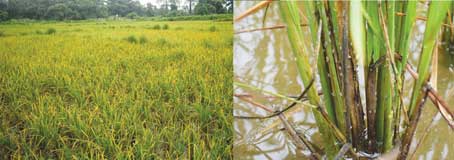[Talo Moyong]
Adding to the damages caused by flood to the ‘rice bowl of East Siang’, an outbreak of white-backed plant hopper (WBPH) is causing extensive damage to the paddy fields in various villages under the Pasighat sadar, Mebo, Geku, Yagrung and Ruksin circles – Mebo and Yagrung circles being the most severely affected.
 The WBPH is one of the most widespread pests out of all the 21 pests of paddy. Both the nymphs (immature stage) and adults of the pest suck plant sap from the leaf sheath region (above the water surface but below the leaf blade) and tend to congregate near it. The leaves of the damaged plants turn yellow, starting from the tip, and then a rust-red colour. In severe cases, the damaged plants usually dry up and die, which results in a brownish hue appearance called ‘hopper burn’. Even if the plant survives, it will not be able to produce ears or panicles, if control measures are not taken in time.
The WBPH is one of the most widespread pests out of all the 21 pests of paddy. Both the nymphs (immature stage) and adults of the pest suck plant sap from the leaf sheath region (above the water surface but below the leaf blade) and tend to congregate near it. The leaves of the damaged plants turn yellow, starting from the tip, and then a rust-red colour. In severe cases, the damaged plants usually dry up and die, which results in a brownish hue appearance called ‘hopper burn’. Even if the plant survives, it will not be able to produce ears or panicles, if control measures are not taken in time.
In order to control the pest, we should take up preventive measures from the nursery stage itself. Since the WBPH first appears in low population during June-July, controlling it is much easier then.
For this, the seed should be treated or mixed with Thiamethoxam 25 wg @ 4 g/kg of seed before sowing, or may be treated with Imidacloprid 17.8 ws @ 5-8 g/kg of seed.
During transplanting, a spacing of 20 x 15 cms between plants and rows should be maintained. By August and September, the pest population becomes quite high, so it is better to monitor the fields from time to time. Spraying of Imidacloprid 17.8 sl @ 1 ml/litre of water of water should be done as soon as the pest first appears, ie, 10 insects/hill. Application may be repeated if the hopper population persists beyond a week after previous application.
In case the field is heavily infested, water draining method along with spraying of Imidacloprid must be done. The field should be drained and kept dry for 2-3 days in a week, and this method should be repeated for at least 3-4 times during the peak infestation period. This will result in reduction of more than 50 percent of pest population.
Other methods include spraying of fungi Beauveriabassiana @ 5 gm/litre of water and also neem-based insecticide @ 1 ml/litre of water. Dead and highly infested plants should be removed and burned. Grassy weeds should be checked, since the insect tend to overwinter on them. After all the control measures, if we spray the plants with micronutrients solution, it will help the plants to revive at a faster rate.
Though these control measures are proven effective, their implementation has come rather late, due to which large areas of paddy fields have already been damaged, which has cost huge loss to the farmers of this region. This will definitely cause a reduction in the rice yield, which may lead to increase in the price of foodgrains. Generally, WBPH infestation is easy to manage if detected early and with proper implementation of the abovementioned control measures.
Lastly, I would like to appeal to the state government to pay some attention to the problems faced by the farmers and take necessary action to prevent the losses and protect the state’s agriculture. (Talo Moyong has a master’s degree in agriculture and entomology, and is an alumnus of CHF, Pasighat.)



